Abstract
The innovative nature of education is determined by the innovative activity of teachers, their attitude to innovations, their readiness and ability to create new educational products and educational technologies, i.e. all that we characterize as innovative behavior. This study aims to analyze the structure of innovative behavior and to examine the factors, influencing the innovative susceptibility and innovative activity of teachers. In this paper are discussed possible approaches to study innovative behavior of teachers. We characterize the manifestations of innovative behavior, determine factors affecting the innovative activity of teachers, identify indicators of assessment of effect of these factors, formulate the formation problem of innovative behavior by management of these factors. The results reveal that teachers from different types of schools have identical characteristics of innovative behavior. It means that not only external factors, but also internal motivation to participate in innovative processes has a significant impact on the teacher’s behavior and that innovative behavior can be formed at both the group and individual levels. It was just an initial study and for the future research, it is recommended to do a deeper study of effect of external factors, such as the organizational culture of the school, the current school management model, the style of leadership, the activities of the school leader to form teacher’s innovative behavior, etc.
Keywords: Innovative economy and knowledge societyinnovative educationinnovative behaviorinnovation activityinnovative culture
Introduction
The formation of innovative economy and knowledge society has led to a number of systemic changes in education. Education is becoming a leading factor in the sustainable development of the state, which determines the new requirements for it and its new basic characteristics, one of which is the innovative nature of modern education (Arkhipova & Kuchmaeva, 2018).
First of all, innovative education means innovative teachers, i.e. teachers who have high innovative culture and innovative consciousness and who demonstrate innovative behavior, which is manifested in a positive attitude to innovations and innovative activities.
Problem Statement
Innovative behavior is traditionally defined as an initiative type of individual or collective behavior associated with the systematic development of new technologies in various spheres of social life or with the creation of new objects of material and spiritual culture (Richmond & Tatto, 2016).
Also, the innovative behavior is determined as the reaction of a person to the changes taking place around him, and as an action in which a subjective attitude to changes is manifested. Prigozhin indicates that the main characteristic of innovative behavior is the active self-consciousness of a person or a group and that the carrier of innovative behavior is a person capable of choosing the type of activity, determining his role in it, developing his own goals and means to achieve them (Thurlings, Evers, & Vermeulen, 2015).
In addition to the concept of "innovative behavior", the following terms can be distinguished as categories reflecting its main manifestations:
Innovation activity, which is determined by the emotional-value attitude to innovations, the level of susceptibility of innovations. Characteristics of innovative behavior depend on how well the teacher is able to assess the current situation and predict their attitude to innovations in terms of profits and losses. The concept of innovation activity is closely related to the category of social inertia that manifests in the delayed reaction to the changes (Sirotin & Arhipova, 2015).
An innovative opportunity that can be defined as the state of the subject associated with the experience of a favorable situation for him and a subjective assessment of the probability of changing its position for the better. A person represents himself as a consumer of innovation - he models a situation in which he takes a new useful experience in innovation process. In addition, an innovative opportunity can be presented as a condition for the manifestation of initiative and creativity, the implementation of own ideas, involvement in the decision-making processes (Uddin, Fan, & Das, 2016).
Innovative thinking is an expression of thought processes of the creation and development of innovations and it is associated with the level of competence, creativity, critical thinking, the desire to find new ways of implementing educational activities (Ilinykh & Udaltsova, 2015).
Innovative consciousness, reflecting the experience of participation in innovation activities and including subjective goals and values of innovation, motivation of innovative behavior, the degree of expression of the need and interest in changes. Innovative consciousness is formed under the influence of social norms, intra - and inter-group relations, which operate within the teacher’s team. At the same time, there may be situations when the innovative consciousness of the teacher differs from the group norms, in this case there are situations of value conflict which itself can become the source of innovation (Mitchell & Boyle, 2015).
Innovative culture. Each organization has a certain type and level of innovation culture, indexed by the ratio of satisfaction or dissatisfaction with the existing situation, readiness or unwillingness to change it (Collie, Martin, Shapka, & Perry, 2015).
Research Questions
Innovative behavior of teachers today is increasingly the subject of scientific research, but most studies focus on the cognitive and operational components of innovative behavior rather than on the value and motivational aspects of teacher’s participation in innovative processes (Galazhinsky & Klochko, 2012; Michailova, Kudinov, & Marin, 2015).
It should be noted that in addition to the analysis of factors that influence the increase of innovative activity of teachers, research and publications that analyze the negative manifestations of innovative behavior have become popular in recent years. These include: resistance to innovation, pseudo-innovative behavior, innovative fatigue, anti-culture of innovation, etc. Researches provide extensive material and a good theoretical basis for empirical research of such types of innovative behavior in educational institutions (Klochko & Galazhinsky, 2009; Klusmann, Ludtke, & Richter, 2016).
This means a qualitatively different format of consideration of social phenomena and processes in education sphere, which requires the development of a special research methodology that allows to integrate theoretical constructs and the results of empirical research of various scientific areas, to model on their basis the relationship of education subjects to various aspects of social reality, as well as to study the dynamics of this relationship.
Purpose of the Study
The relevance of this study is due to the incomplete of theoretical justification of models of innovative behavior in the educational sphere, as well as the need to attract the attention of the scientific community and specialists of education management to the problem of formation and effective use of innovative potential of teachers, the need to study its specificity and mechanisms of its development.
Thus, this study aims to analyze the factors influencing the innovative behavior of teachers, as well as the conditions of its formation.
Research Methods
The research program included the following stages.
1. Definition and clarification of the main concepts of the study.
The study focuses on the following local objects:
innovative potential, differentiated at 4 levels: genetic, physiological, and psychological aspects; the aspect of the individual’s ontogenetic development; aspect of socialization; the level of competence acquired in the process activities;
characteristics of innovation processes, the results of innovation;
active participation in innovation activities.
2. Definition of the sample size of the study.
Since the educational system is a rather complex and heterogeneous object, this involves the definition of a representative sample using cluster analysis, in which the whole population is divided into certain classes (Kraft, Marinell, & Shen-Wei Yee, 2016). Cluster analysis was used to classify research objects (schools) into relatively identical groups. In this study we applied a hierarchical cluster analysis - a method of tree clustering, used in the formation of clusters of dissimilarity or distance between objects. Thus, we had an additional opportunity to identify the presence of innovative behavior depending on the chosen method of classification (factor).
Of the three clusters identified for the study (1- ordinary school, 2 – experimental school, 3 - resource center school) one school in each cluster was randomly selected. A total of 36 teachers took part in the study (12 from each school).
3. Conducting empirical research.
To obtain a reliable, dependable and valid results it is necessary to use a fairly diverse and representative set of research methods (Gargani & Strong, 2014).
The use of proven techniques, such as, for example, the Harvard personality questionnaire, the test of thematic apperception of Hekhauser, the adaptation-innovation questionnaire of Kerton, the questionnaire of personal styles of Millon, questionnaires of Nikishina and Morozova, adapted to research in the educational sphere, was adequate for our study. To identify typological groups of teachers, depending on their innovative potential, the "Questionnaire of the level of innovation of teachers in the school team" was used. To study the most significant motivational factors that encourage teachers to innovative activities the "Motivational readiness of the teachers to assimilation innovations" was employed, for the diagnosis of typical problems the "Barriers to the development of innovations" was engaged. The teacher’s readiness to innovate was studied using the questionnaire "Susceptibility of teachers to innovations".
The formalized questionnaire survey and in-depth focus group interviews were used to obtain information directly from the respondents. It is the most efficient way to collect data in such research. The survey was conducted using a specially designed google-form that allows you to automate data collection and simplifies the processing of results.
4. Processing of results
Data processing was implemented by the SPSS complex. The use of mathematical statistics methods allowed to confirm the correctness and reliability of the sample, to prove the hypotheses. With the help of descriptive statistical methods, charts and tables were built to illustrate the dynamics and parameters of the answers to each question.
Findings
The first question of the questionnaire determined the teacher’s general understanding of the importance of innovation for the development of educational institutions and for them personally. 100% of respondents noted the high relevance and importance of innovation for modern education and recognized the need for participation of each teacher.
The results of the survey on the "Questionnaire level of innovation of teachers in the school team" are shown in Figure
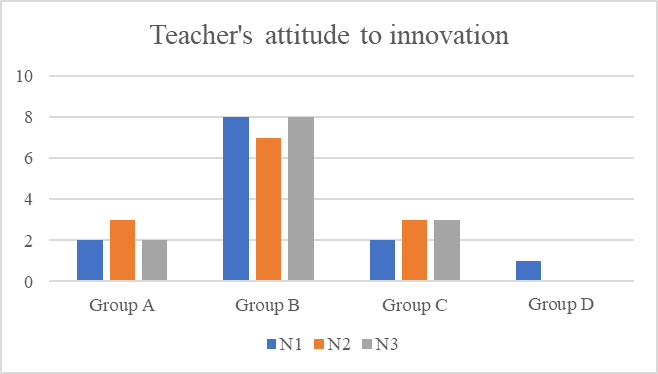
Figure
To the factors determining the involvement of teachers in innovative activities (Figure
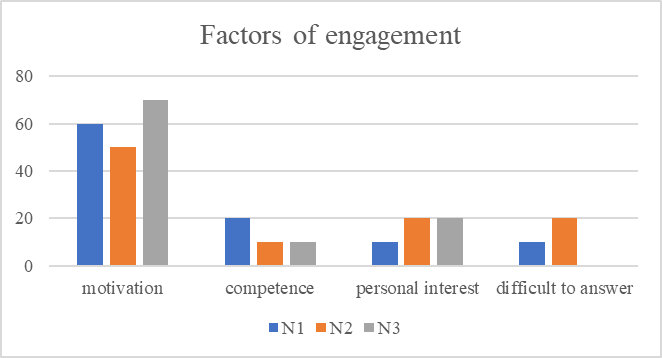
A more in-depth study using "Motivational readiness of the teachers to develop innovations" allowed to determine the factors that encourage teachers to innovate (Figure
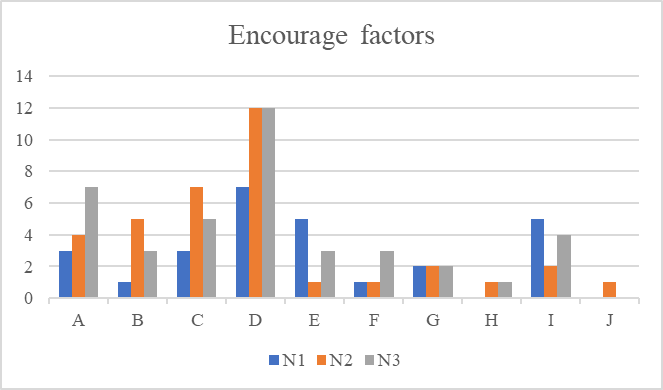
A similar study was taken with respect to barriers to innovation (Figure

Respondents note that the level of innovation activity could be significantly higher if properly organized, regular and timely information about planned innovations and best innovative practices is provided. It is noteworthy that none of the respondents noted as an obstacle to innovation the factor of conflict in the team and the lack of pedagogical experience (Table
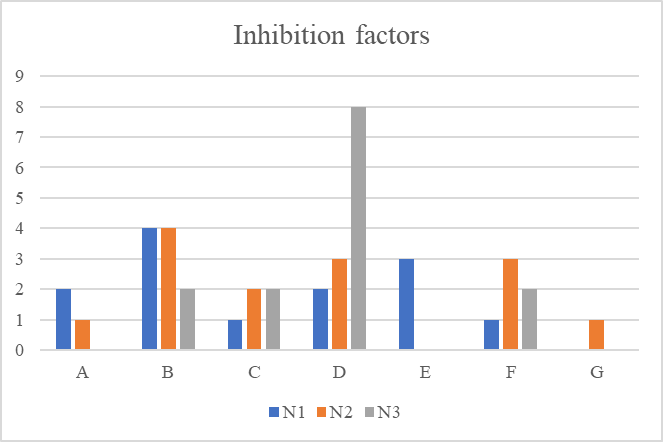
The results of the research of teacher’s readiness for innovative activity are presented in Figure
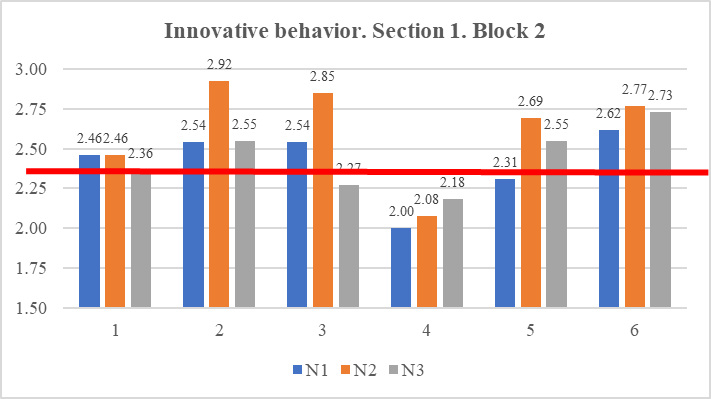
The level of teacher’s susceptibility to innovations (K) is determined as:
where – the actual number of points received by all respondents; - the maximum possible number of points.
K < 0.45 - critical level;
0.46 < K < 0.65 - low level;
0.66 < C < 0.85-permissible level;
K > 0.86 - optimal level.
The collecting data allowed to calculate the coefficient for each of the schools:
school N1 - K = 0.48
school N2 - K = 0.53
school N3 - K = 0.49,
which, unfortunately, corresponds to the low level for each of the studied schools irrespective of their type.
Conclusion
This research allowed to obtain the following results:
the place of the research question about teacher’s innovative behavior in ensuring the innovative characteristics of modern education was determined;
the structure of the innovative behavior of teachers was identified and its basic characteristics were indicated, the factors that influence the formation and manifestation of innovative behavior were analyzed;
on the basis of research of innovative behavior of teachers, the prospective directions of formation of teacher’s readiness for innovative activity are determined.
This study allowed to test the research tools, to check the validity of the questions in the questionnaires, to improve the methods of scaling and data grouping, to create the foundation for more extensive research. The results of this study allowed to determine the directions of the subsequent research search and to form hypotheses for further studies.
In this paper the problem of studying the innovative behavior of teachers is considered. The factors that positively and negatively affect innovative behavior are described. The possibilities of application of some research methods for the study of innovative behavior of teachers are shown.
Acknowledgments
This work was financially supported by the Russian Foundation of Fundamental Researches (grant no. 18-013-00646\18).
References
- Arkhipova, M., & Kuchmaeva, O. (2018). Social demand of Russians for innovation (according to a sample survey). Economic and Social Changes: Facts, Trends, Forecast, 11(2), 69-83, doi: 10.15838/esc.2018.2.56.5
- Collie, R.J., Martin, A.J., Shapka, J.D., & Perry, N.E. (2015). Teachers' Psychological Functioning in the Workplace: Exploring the Roles of Contextual Beliefs, Need Satisfaction, and Personal Characteristics. Journal of Educational Psychology, 108(6), 788-799
- Galazhinsky, E., & Klochko, V. (2012). System anthropological psychology: methodological foundations. Psychology in Russia: State of the Art, 5, 81-98
- Gargani, J. & Strong, M. (2014). Can We Identify a Successful Teacher Better, Faster, and Cheaper? Evidence for Innovating Teacher Observation Systems. Journal of Teacher Education, 65(5), 389-401
- Ilinykh, S., & Udaltsova, M. (2016). The meaning of human life and self-satisfaction: sociological discourse. Indian Journal of Science and Technology, 9(14), 91079, doi: 10.17485/ijst/2016/v9i14/91079
- Klochko, V., & Galazhinsky, E. (2009). Innovative potential of personality: systemic anthropological context. Psychology in Russia: State of the Art, 2, 210-224
- Kraft, M.A., Marinell, W.H., & Shen-Wei Yee, D. (2016). School Organizational Contexts, Teacher Turnover, and Student Achievement: Evidence From Panel Data. American Educational Research Journal, 53(5), 1411-1449
- Klusmann, U., Ludtke, O., & Richter, D. (2016). Teachers' emotional exhaustion is negatively related to students' achievement: Evidence from a large-scale assessment study. Journal of Educational Psychology, 108(8), 1193-1203
- Michailova, O., Kudinov, S., & Marin, J. (2015). Value-motivational characteristics of innovativeness as prospects for successful self-fulfillment. Mediterranean Journal of Social Sciences, 6(3), 105-112. doi: 10.5901/mjss.2015.v6n3s2p105
- Mitchell, R., & Boyle, B. (2015). Professional diversity, identity salience and team innovation: The moderating role of open mindedness norms. Journal of Organizational Behavior, 36(6), 873-894
- Richmond, G., & Tatto, M.T. (2016). Innovation in Educational Research. Journal of Teacher Education, 67(5), 360-362
- Sirotin, V., & Arhipova, M. (2015). Cooperation and innovation activity: study of the relationship at the regional level. In B.Galbraith (Ed.) Proceedings of the European conference on innovation and entrepreneurship, issue 10, (pp.673-682). Genoa: University of Genoa.
- Thurlings, M., Evers, A.T., & Vermeulen, M. (2015). Toward a Model of Explaining Teachers’ Innovative Behavior: A Literature Review. Review of Educational Research, 85(3), 430-471.
- Trapitsin, S., Granichina, O., & Granichin, O. (2017). Information and mathematical models for evaluation of the effectiveness and quality of the university. In Proceedings of the 2017 International Conference "Quality Management, Transport and Information Security, Information Technologies", IT&QM&IS-2017 (pp.287-291). Piscataway, USA: Institute of Electrical and Electronics Engineers doi: 10.1109/ITMQIS.2017.8085813
- Uddin, M.A., Fan, L., & Das, A.K. (2017). A Study of the Impact of Transformational Leadership, Organizational Learning, and Knowledge Management on Organizational Innovation. Management Dynamics, 16(2), 42-54.
Copyright information

This work is licensed under a Creative Commons Attribution-NonCommercial-NoDerivatives 4.0 International License.
About this article
Publication Date
30 December 2018
Article Doi
eBook ISBN
978-1-80296-050-1
Publisher
Future Academy
Volume
51
Print ISBN (optional)
-
Edition Number
1st Edition
Pages
1-2014
Subjects
Communication studies, educational equipment,educational technology, computer-aided learning (CAL), science, technology
Cite this article as:
Trapitsin, S., Granichin, O., Granichina, O., & Zharova, M. (2018). Innovative Behavior Of Teachers: Definition And Analysis. In V. Chernyavskaya, & H. Kuße (Eds.), Professional Сulture of the Specialist of the Future, vol 51. European Proceedings of Social and Behavioural Sciences (pp. 350-359). Future Academy. https://doi.org/10.15405/epsbs.2018.12.02.37

